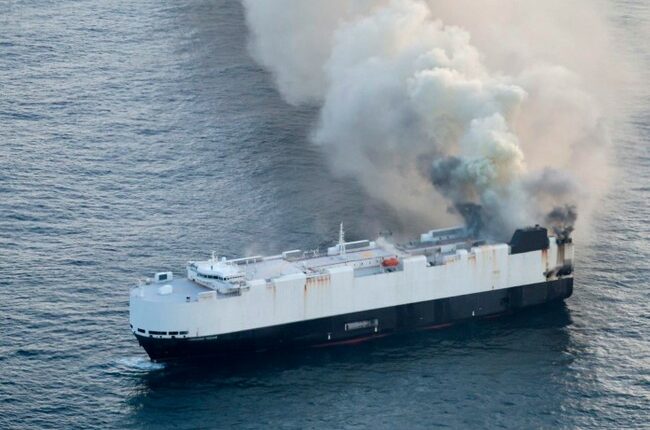
We’ve covered enough of these rather spectacular shipboard fires here that I’d imagine most everyone has a pretty good idea what this is in reference to.
Boats packed to the gills with thousands of vehicles, even if only a small percentage of them aboard are electric, become floating, unquenchable volcanic islands when the lithium batteries in one or more of the EVs overheat or explode, and start burning. Almost invariably, they take the entire ship with them.
Even when EVs are not the cause of the fire, as is still being debated in the case of the 2023 Fremantle Highway ship disaster, their presence onboard makes firefighting nearly impossible. In Fremantle’s case, the fire on the ship prevented the crew from reaching their lifeboats, and one crew member perished in the mad dash jumping overboard into the open sea.
…Lithium-ion battery fires are notoriously difficult to extinguish, and there are currently no methods available for safely fighting an EV fire onboard once it has taken hold.
With increasing numbers of EVs being carried onboard passenger ferries as well as cargo ships, the industry urgently needs to review its fire safety measures.
This would need to include abandon ship procedures, as crew members from the Fremantle Highway were forced to jump into the sea because lifeboats could not be used, and one seafarer lost his life this way.
…He noted that the ceilings of the decks are very low, meaning that there is little space above the cars and smoke from any fire fills the deck immediately, making it very difficult to find the vehicle that is the source of the fire.
Crew movement is also hampered by the lashings between the cars.
‘It is almost impossible to extinguish these fires by manpower,’ he continued. ‘The only way is to seal the compartment and flood it, but the decks are very open.’
After the string of car carrier fires began, a Norwegian ferry operator banned them from their boats primarily due to the risk of being caught at sea when one started.
Well, that and that there’s no way to extinguish it once it starts.
Electric vehicles are so prone to spontaneously bursting into flames—which are virtually impossible to put out—that a Norwegian shipping company has banned them from its ferries, citing a ship that sank last February after the EVs it was carrying caught fire and couldn’t be… pic.twitter.com/pkGCHNFBZY
— Wide Awake Media (@wideawake_media) October 5, 2023
The latest EV-related car carrier fire in the news was just a month ago, when the Morning Midas out of Yantai, China, and loaded with vehicles – 800 of them electric – caught fire off the coast of Alaska. Thankfully, merchant vessels in the area diverted and came to her aid immediately, and the crew were all able to abandon ship safely.
Morning All👋
The Morning Midas a 600-foot Pure Car and Truck Carrier (PCTC), carrying 3,159 vehicles, including 65 fully electric vehicles and 681 partial hybrid electric vehicles, is still on fire🔥
No doubt the BBC are covering it extensively. pic.twitter.com/5Byrh57Azw
— Electric Blue🧢🖌 (@Only9built) June 7, 2025
A salvage crew and tug got out to the Morning Midas, but all efforts were for naught, as the fire burned away until the ship slipped into the briny deep almost three weeks later.
Fire-damaged Morning Midas car carrier sinks pic.twitter.com/vuQq9ST76O
— Splash (@Splash_247) June 24, 2025
Apparently, that’s enough fire and brimstone for one of the largest United States shipping firms operating in the Pacific. The company is not going to allow EVs and plug-in hybrids on its vessels anymore.
The risks are too great, and the firefighting technology to handle lithium-ion batteries when they’re in thermal runaway or actually on fire is just not there yet.
Matson Suspends Electric Vehicle Shipments Over Battery Fire Concerns
…“Due to increasing concern for the safety of transporting vehicles powered by large lithium-ion batteries, Matson is suspending acceptance of used or new electric vehicles (EVs) and plug-in hybrid vehicles for transport aboard its vessels,” the company stated in a customer advisory.
The decision follows several high-profile maritime incidents involving lithium battery fires, including the recent sinking of the Morning Midas in the North Pacific this June. The 600-foot vessel was carrying 3,159 vehicles, including 65 fully electric vehicles and 681 partial hybrid electric vehicles when smoke was detected from a deck carrying electric vehicles.
Despite crew efforts to deploy emergency firefighting protocols, the intensity of the fire forced all 22 crew members to abandon ship.
This incident echoes the February 2022 Felicity Ace disaster, where the car carrier caught fire in the mid-Atlantic and eventually sank with nearly 4,000 vehicles on board. Speculation has focused on lithium batteries in electric vehicles as the potential cause.
Maritime safety experts point to thermal runaway as the primary hazard with lithium-ion batteries. This phenomenon occurs when a battery enters an uncontrollable, self-heating state that can result in the ejection of gas, shrapnel, or particulates along with extremely high temperatures.
The Coast Guard has already issued new warnings on the ‘extreme risks’ of loading damaged EVs on commercial vessels, such as those that’d suffered saltwater intrusion like during Hurricane Ian. I’m assuming those were sold as ‘used’ or salvaged vehicles, and yeah. That could be bad, if you recall what happened with some of the EVs from Ian which were swamped during the storm surge or inland flooding. They looked fine, had maybe even dried out, and then their battery would suddenly cook off.
Officials warn that EVs could catch fire if inundated with saltwater from Hurricane Helene. Maybe we need to wave the red flag on the mad rush to force EVs on Americans if they cannot offer the same or less water-related damage risk as ICE cars. pic.twitter.com/BAH2P418ZN
— Tom Vierhile (@TomVierhile) September 27, 2024
Bad enough if it was still under what was left of your house. Much worse if it was one of thousands of cars stacked in the hold, and the ship is in the middle of nowhere with nothing but the big blue around it.
As you might imagine, not every shipbuilder or EV manufacturer is quite as fussy about safety controls and the health or environmental risks involved in moving their product. If it ends up at the bottom of the ocean, there’s always more product and ships to carry it where that came from.
Consequently, the Chinese are going gangbusters building both.
Chinese automakers are building massive shipping fleets to export EVs around the world, following in the footsteps of Japan and South Korea. Here’s BYD’s fleet so far.
From Christopher Chico’s Battery Chronices newsletter: pic.twitter.com/7oRBDLGmas
— Kyle Chan (@kyleichan) June 1, 2025
What a surprise.
Here at HotAir, Ed, David, John, and I don’t bring you just political news. We take a lot of satisfaction in making sure our readers have a full spectrum of pieces to mull over…and sometimes even laugh really hard at (Okay – well, that’s mostly me.).
But we can’t do any of it without your help, and would like very much to invite you to join our HotAir VIP program. Right now, you can get 60% off the membership cost with promo code FIGHT.
Again, we thank you for being here with us at HotAir and look forward to seeing you in the comments!








